Lesson 2: Biomes
Objectives
By the end of this lesson, students will be able to:
describe the climate of and organisms that live in the six terrestrial biomes
identify the characteristics of freshwater biomes
compare and contrast estuaries and oceans
distinguish between the three ecosystems within an ocean
explain the impact humans have on terrestrial and aquatic biomes
Click here for the course glossary
Introduction
Why do you think you will never see a polar bear in southern California? Why will you never meet an arctic fox in Texas? Both polar bears and arctic foxes live in cold climates because those climates suit them. Lesson 1 described factors that determine organisms' habitats. Two abiotic (non-living) factors include temperature and rainfall.
This lesson describes the Earth's major ecosystems. This lesson also compares climates and the lives of plants and animals in different ecosystems. Climate determines the plant and animal life found on land. Aquatic ecosystems vary based on temperature and the depth that light can penetrate the water. Finally, the lesson also describes the way animals have adapted to their habitats.
|
This aquatic environment, the ocean, has many ecosystems within it. |
A desert is an example of one of the major land ecosystems on Earth. |
What is a Biome?
In Lesson 1, you read about ecosystems. Ecosystems are made up of organisms and the abiotic factors present. Major ecosystems are called biomes. Biome type is based on vegetation and organisms' adaptations to the environment. There are both land biomes and aquatic biomes. Deserts are one type of biome. Deserts cover a large portion of Africa. They make up parts of Australia and South America. Desert regions are also found in the Middle East, Central Asia, and the southwest United States. Like deserts, all biomes occupy large geographic areas.
Terrestrial Biomes
Terrestrial biomes are land biomes. Temperature, precipitation, and plant-life determine biome-type. Plants are the primary producers that support all life in the biome. Plants affect the fungi, animals, and microorganisms around them. Plants and animals have adapted to their specific biomes. This enables them to survive there.
This lesson will describe the six major terrestrial biomes. These include tropical rain forests, deserts, grasslands, deciduous forests, boreal forests, and tundra.
Tropical Rain Forest
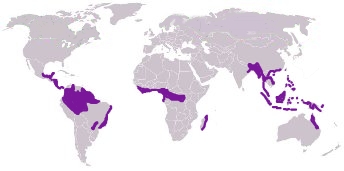
The dark purple areas represent the parts of the
world that are covered by tropical rain forests.
Tropical rain forests are located close to the equator. They are found mainly in areas of Africa, South East Asia, and Central and South America. Rain forests cover only about 6% of Earth's surface. They have more species of plants and animals than all other biomes combined.
The rain forest climate is warm and humid year round. There are 12 hours of sunlight per day. Rainfall ranges from 79-157 inches per year. The amount of rain determines the type and height of plants growing in that location. Rainwater drains nutrients from the rain forest soil. As a result, the soil does not contain many nutrients.
Plants that Live in the Tropical Rain Forest

A lush tropical rain forest.
Plant diversity is higher in tropical rain forests than in any other habitat on Earth. Hundreds of different species may be found in just a small area of a rain forest. The trees found in tropical rain forests form two distinct layers. The leafy top of the forest is called the canopy. It consists of many tall trees that grow anywhere from 50 to 200 feet high. Below the canopy is the understory. The understory is made up of many shrubs, vines, and shorter trees. The understory receives less sunlight. Plants there have adapted to life in the shade. Vines have also adapted by growing on tall trees to reach sunlight. Some plants have also developed larger leaves. This gives them a greater chance of catching the sunlight.
Rain forest plants have also had to find ways not to get saturated. Saturated means that it is too wet. Many trees in these forests have developed special roots. These roots add extra support so the tree can remain standing in wet soil. In addition, many plants have drip tips which help them get rid of excess water. Plants with this adaptation have leaves that are long, narrow, and downward curling.
Animals that Live in the Tropical Rain Forest
The animal diversity in tropical rain forests is higher than in any other habitat on Earth. A four square mile area of rain forest likely contains:
400 species of birds
125 species of mammals (such as deer)
100 species of reptiles (such as lizards)
60 species of amphibians (such as frogs)
thousands of species of insects
Insects and creatures like sloth, deer, and monkeys eat plants. Animals such as large cats and snakes eat the animals that eat the plants in the forest. Many rain forest animals have adapted ways to live and thrive in and around trees. For example, monkeys, apes, squirrels and tree shrews are well adapted to move easily from tree to tree.
|
A macaw is one of the many species of birds found in a tropical rain forest. |
A jaguar is one of many species of mammals found in a tropical rain forest. |
Desert
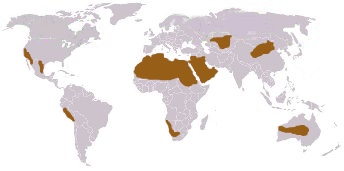
The brown shaded areas represent locations on
Earth where deserts are located.
Deserts are found all around the world. They are in the southwest United States and parts of South America. Australia, Africa, the Middle East, and Central Asia also have deserts. Most deserts receive less than eight inches of rain per year. Some deserts do not get any rain during an entire year. Desert skies rarely have clouds. Temperatures can be scorching. Deserts are hot during the day, but often turn cold at night. Organisms have adapted to this extreme environment. Biodiversity varies from one desert to another. A desert in southern Arizona has moderate rainfall. As a result, it contains many organisms. Africa's Sahara desert, which gets less than one inch of rainfall per year, has no living things.
Plants Found in the Desert
Desert plants include wildflowers, cacti, trees, shrubs, and grasses. Not all of these plants are found in all deserts. It depends on the rainfall. Recall that plants need water in order to undergo photosynthesis in order to make food to survive. Thus, desert plants have adapted to very little rain. Many cacti have roots that are shallow but widespread. This increases their chances of finding a water source underground. A saguaro cactus has stems that work like a pleat on an accordion. The stems expand to store water when it rains. Then they fold back in during times of drought. Many shrubs in the desert have long taproots that reach groundwater far below the surface. Many desert plants also produce chemicals that prevent other plants from growing nearby. This decreases competition for water.
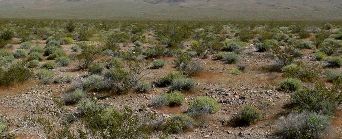
The Mojave Desert, California
Animals Found in the Desert
Animals have also adapted to the desert climate. Some burrow underground during the hot days and are more active at night. One type of lizard, the Gila monster, stays cool by burrowing underground for several weeks at a time. Some animals have adapted ways to prevent body water loss. Reptiles like lizards and snakes have leathery skin that prevents water loss. Scorpions have exoskeletons to prevent water loss as well. Some mice in the desert get all of their water from seeds that they eat. Many of these mice rarely drink since water is so scarce.
Camouflage is another desert adaptation. Many animals are similar in color to the desert landscape. These colors help them hide from predators. The disguise increases their chances of survival. Camouflage is an adaptation found in other biomes as well.

Find the camouflaged snake in this picture. This
snake is found in Ras Mohammed National Park
desert, located at the tip of the Sinai Peninsula.
Grassland
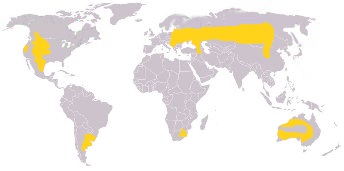
The yellow shaded areas represent locations on
Earth where grasslands are located.
Grasslands, also called prairies, are found in parts of North, Central, and South America. Africa, Central Eurasia, and Australia also have grasslands. Grassland winters are cold. Summers are warm with some rain. Grasslands typically receive 10-40 inches of rain per year. This is more rain than a desert, but not enough rain for trees to grow. Three factors allow grasslands to endure. These are drought, grazing of grass by animals, and occasional fires. All of these factors prevent trees and woody plants from growing. Grass can thereby maintain dominance.
Plants Found in Grasslands
Grassland plant life includes grasses and non-woody plants. Oats, wheat, prairie clover, and barley are a few examples of grassland plants. The soil is rich in nutrients. Because of this, many of the grasslands in the United States have been taken over as farmland.
Grasses have adapted to life in these low-rainfall environments. Grass height reflects rainfall levels. The more rain there is, the higher the grass will grow. The different shapes and blade textures help grasses conserve water. Grass roots also travel far in the soil to obtain water. Some grasses have roots that go as far as six feet underground.
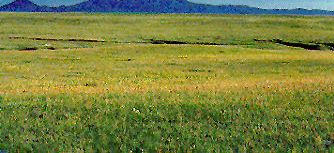
A grassland
Animals Found in Grasslands
Animal life depends on the grassland's location. Jaguars are in the grasslands of South America, but not in North America. Large herbivores are typically found in grasslands. These include elephants, bison, zebras, and kangaroos. In North America, bison, elk, and pronghorn antelope once grazed the grasslands in large numbers. These herbivores are preyed upon by predators like gray wolves and coyotes. Smaller herbivores, such as insects and rodents, can also be found in grasslands.
Human activity such as farming has reduced diversity of both animals and grasses
in this biome.
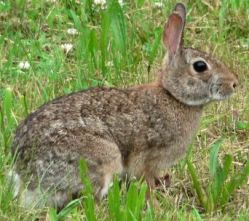
Eastern cottontail rabbits are fast-
moving mammals found in grasslands.
Temperate Deciduous Forest
Temperate deciduous forests are found in the eastern United States, Canada, and Europe. They also appear in China and Japan. Their summers are hot and wet. Winters are cold. This biome experiences four distinct seasons. The growing season for plants lasts five or six months each year. Rainfall in these forests ranges from 26 to 118 inches per year. Rainfall is spread out evenly throughout the year.
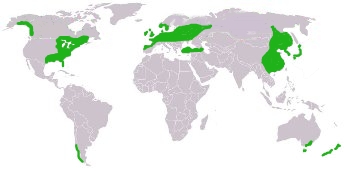
The green shaded areas represent locations on
Earth where deciduous forests are located.
Plants that Grow in Temperate Deciduous Forests
Temperate deciduous forests are more open than rain forests. But, the trees are not as tall. Additionally, soils in temperate deciduous forests are rich in nutrients. Trees in these forests have adapted ways to survive the four different seasons. Leaves change colors in the fall. They fall from the trees in the winter. They grow back again in the spring. During the warmer spring and summer times, trees flower. The cycle of shedding leaves and growing new ones takes place every year. It is too cold for the plants to photosynthesize in the winter. Trees have no need for green leaves at that time. Thick bark is another adaptation for cold weather.
Deciduous forests contain a variety of trees and other plants. Maple, oak, and beech are examples. These broadleaf trees are often found in high densities in these forests. Many of the trees have ball-shaped tops. This maximizes the intake of light for photosynthesis. Shrubs, herbs, and mosses are found below the tall trees of a temperate deciduous forest.
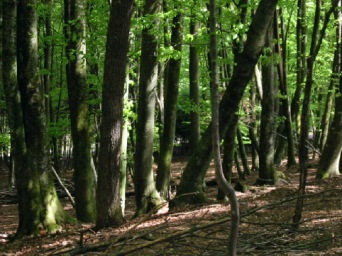
A deciduous beech forest in Europe
Animals Found in Temperate Deciduous Forests
Many animals inhabit temperate deciduous forests. Animals include insects such as ants, white-tailed deer, porcupines, squirrels, and black bears. Many of the animals have successfully adapted to the cold winters. Several bird species migrate from these forests to warmer areas in winter. Many mammals, like bears, hibernate during the winter. Other mammals get fat or grow thicker coats of fur to keep them warm in the winter.
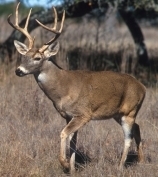
White-tailed deer
Boreal Forest (Taiga)
Boreal forests have long, cold, and dry winters. These are also known by the Russian name taigas. The summers in these forests are moderately warm and moist. They do not last long. There are only about 50-100 frost-free days in a boreal forest. These forests are found in areas of North America and Russia.
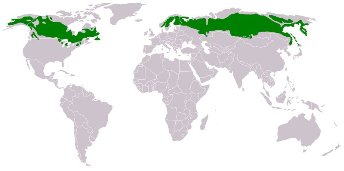
The dark green shaded areas of this map represent
places on Earth where boreal forests are located.
Plants Found in Boreal Forests
Conifers are the dominant trees of boreal forests. Examples of coniferous trees found in boreal forests are pine, fir, and hemlock. These types of trees have needles instead of leaves. They have cones instead of fruit. Conifers are also called evergreens. Their needles stay green for most of the year. This helps them live in a climate where the winters are long, and the growing season is short.
When temperatures are warm and perfect for growth, these trees do not have to go through a process to turn their leaves green. Their leaves are already green. Thus, they may photosynthesize as soon as temperatures are right. The dark green color of their leaves is also an adaptation for living in a climate with long winters. The dark color helps absorb the maximum amount of sunlight for photosynthesis.

Needles on a coniferous tree
Animals Found in Boreal Forests
Many animals found in the boreal forests are adapted to long winters. Many predators in boreal forests have fur. Lynx and weasels, such as wolverines, are among the predators that live in these forests. They prey upon herbivores like snowshoe hares, red squirrels, and lemmings. Some of the herbivores in the boreal forests eat the seeds from the trees, while others feed on tree bark and new shoots. Many birds that feed on insects migrate from the boreal forests after the breeding season. Some birds, like sparrows, feed on seeds. They stay in the boreal forests year round.

Wolverines are predators commonly found
in boreal forests.
Tundra
The tundra is the coldest of all the biomes on Earth. Tundra can be found south of the ice caps of the arctic into North America, Europe, and Siberia in Asia. Half of Canada and much of Alaska are tundra. The climate of this biome is extremely cold and dry. Winters are long, dark, and cold. High winds of 30-60 miles per hour are also a characteristic of a tundra biome. Like a desert, a tundra gets little rain. The average yearly rainfall in a tundra is between six and ten inches. Tundra can warm up during the short summer period. It is often rainy and foggy during this time.
Permafrost is another characteristic of a tundra. This is permanently frozen subsoil. During the short summer, the top layer of the soil thaws, but the layer underneath it stays frozen. Rain does not get through the permafrost. This causes water to build on top of the soil. Shallow ponds form as a result.

The orange shaded areas are the locations
on Earth where tundra is located.
Plants Found on a Tundra
Due to the extreme temperatures and high winds, there are no tall trees on a tundra. Grasses, shrubs, and some dwarf forms of certain trees dominate tundra biomes. There is a short growing season; summer days are long, but few in number. During the winter, trees stay close to the ground so they are insulated by the snow. Tundra biomes have low biotic diversity of both plants and animals.
Animals Found on a Tundra
Many types of birds are found on a tundra in the summer. Insect-eating birds fly south to warmer areas during the winter. Mammals also live on the tundra. These include caribou, wolves, and foxes. Many of these mammals grow thick fur for insulation in the winter months. Caribou scrape the ground for food in the cold months. Wolves will hunt sick and injured caribou during the winter.
Camouflage is another adaptation for survival on a tundra. Snowy owls, polar bears, and arctic foxes are white to blend in with the snow. The fur of the arctic fox, and other mammals living in the tundra, changes color with the season so that the animals are camouflaged all year.
|
An arctic fox during the summer |
An arctic fox during the winter changes color and grows more fur. |
Think About It
What type of biome do you live in? Explain how your area's climate and the
organisms that live there represent that specific biome.
Aquatic Biomes
Aquatic biomes make up the largest part of the biosphere. Aquatic biomes include areas of freshwater and saltwater. They also include areas where freshwater meets saltwater. Approximately 70% of Earth is covered by marine ecosystems. This includes oceans and estuaries. A much smaller amount is covered by freshwater. An abundance of life is found in these aquatic ecosystems. Aquatic life ranges from microscopic organisms to large predators, such as sharks.

This photo shows only the western
hemisphere on Earth. Notice how
much of Earth is covered in water.
Abiotic factors affect organisms in aquatic ecosystems. The following are some of the abiotic factors that affect the survival of aquatic organisms:
sunlight
temperature
nutrients in the water
salt content
oxygen levels
Freshwater
Salt concentration determines whether an aquatic ecosystem is considered freshwater or saltwater. On average, freshwater ecosystems have salt concentrations of less than 1%. Only a small amount of the water on Earth is freshwater. These ecosystems can be found in many places all over the world. North America, Asia, Africa, and South America have many freshwater sources. Freshwater biomes can be divided into two categories. These are based on the flow of water. The first group is made up of streams and rivers. The second group consists of ponds and lakes.
Streams and Rivers
Streams and rivers are aquatic ecosystems with running water. Think of streams as smaller versions of rivers. Running water usually starts from a higher altitude (such as a mountain) and runs down to a lower altitude. Streams turn into rivers. Rivers eventually feed into oceans.
At the beginning of a stream, water moves fast. Because of the flow of the water, organisms that live in streams must adapt to this condition. Many insects and other organisms, such as snails, find ways to attach themselves to rocks or logs. This prevents the current from pulling the organisms downstream. Many fish in this part of the stream, such as trout, have streamlined bodies. This helps them swim with the water current.
High levels of oxygen are also present in this fast-moving part of the stream. However, few plants grow here. Any organism that eats plant life depends on the vegetation from outside of the lake to survive.
As the stream continues to flow down toward the ocean, other streams join it. These streams form a river. The movement of the water is slower and cloudier than it was upstream. In contrast to the fast flowing stream, there is much less oxygen in a river. The water is also warmer. Plants can now grow in the river, and more life forms are found here. Crayfish, catfish, and worms are examples of organisms found in a river.

A fast-flowing stream
Ponds and Lakes
Ponds and lakes are aquatic ecosystems with standing water. A pond is a smaller, shallower version of a lake. Sunlight can more easily penetrate ponds.
There is a great diversity of living things in lakes and ponds. Organisms in these two ecosystems have adapted to life in or near still water. Turtles, frogs, and other reptiles and amphibians live on the edge of lakes and ponds. Insects, such as diving beetles and water scorpions, also live there.
Scavengers and decomposers (including bacteria) commonly live at the bottom of these aquatic ecosystems. Water birds live in or around ponds and lakes. They feed on fish and other small organisms. Most plant life is located on the edge or in the shallow areas of lakes and ponds. These waters sustain both floating and rooted plants.

Crater Lake, Oregon, is the deepest lake in the
United States (maximum depth is 1,932 feet).
Marine (Saltwater)
Rivers eventually feed into the ocean. This part of the lesson describes oceans and aquatic ecosystems that are brackish. Brackish refers to a mix of fresh and saltwater.
Estuaries
Estuaries are ecosystems with both freshwater and saltwater. An estuary is located where the freshwater from a river meets the saltwater of the ocean. Estuaries vary in size and shape. They are also called bays, lagoons, or inlets. Examples of estuaries in the United States include Tampa Bay (in Florida) and Chesapeake Bay. The salt concentration of an estuary is not as high as that of the ocean. However, its concentration can change with the tides. When the tide comes in, more salt enters the estuary. When the tide goes out, salt concentrations decrease.
Estuaries are one of the most productive ecosystems on Earth. About
two-thirds of the fish and shellfish we eat (such as crabs and shrimp) spend at
least part of their life in an estuary. These ecosystems are considered major
nursery grounds for many animals, including young fish and shrimp. Sea grasses
are plentiful in many estuaries. They serve as the nursing ground for most of
these organisms. Fish also use these grasses as hiding places to escape
predators.

An estuary in Puerto Rico
In some estuaries, young sea turtles graze on sea grass. Water birds, such as Great Blue Herons and pelicans, also nest nearby. These birds also feed on the diverse organisms that live in this ecosystem.
Estuaries also contain mammals. Marine mammals, such as dolphins, enter estuaries from the ocean to feed on fish. Manatees, a plant-eating marine mammal, also feed in estuaries.

A manatee, a marine mammal commonly
found in estuaries.
Oceans
Oceans contain many different ecosystems. These ecosystems are separated into different zones. There are intertidal, neritic, and oceanic zones. These zones represent differences in depth of water, distance from the shoreline, and the amount of light that gets through the water. Organisms vary from zone to zone. In addition to these zones, this section describes coral reefs. A coral reef is an ecosystem within an ecosystem (within the neritic zone).
This part of the lesson expresses ocean depths in meters. If you want to convert these measurements to feet or inches, use the following numbers:
3.28 feet = 1 meter
39.36 inches = 1 meter
 |
Intertidal
Zone: This is the area between the highest and lowest tide lines. The
tides will determine which part of this zone is covered with water and at what
times of day. The waves that hit this zone are strong. Thus, not many plants
live in this area of the ocean. The intertidal zone sees several daily shifts
in water level, water temperature, and nutrient levels. Tides cause these
shifts. Organisms living in this zone have adapted to these daily changes.
Many animals, including sea stars and barnacles,
attach themselves to rocks so that waves do not throw them about. Many
different types of birds are also found in this area. They feed on the
organisms found in the mud.
Neritic Zone: Just beyond the intertidal zone is the neritic zone. It extends from the lowest tide mark to the continental shelf. This zone reaches closer to the open ocean. The water depth here can get to 200 meters, which is quite shallow. However, because the water is so shallow in this zone, sunlight can easily get through. Therefore, many algae, which photosynthesize, live in the neritic zone. Many different types of fish swim in this zone to look for algae to eat. Corals form in warmer areas of the neritic zone.
Coral
Reefs: Coral reefs are some of the oldest and most diverse ecosystems on
Earth. They are found in the warm waters of the neritic zone and they are
their own distinct biome. The constant wave action over the reefs supplies the
organisms that live there with nutrients to survive. Reefs provide habitats
for a variety of organisms. These include fish, sea stars, sea horses, and
lobsters. Many organisms use coral reefs to hide from predators. Others use
them as a food source.

The Great Barrier Reef, Australia
Oceanic Zone:
The biome
located just beyond the neritic zone is the oceanic zone. This is the
open-ocean. Sunlight can only penetrate a few hundred meters of water, so the
deeper areas are quite dark. This zone is divided by depth into two more
zones. They are the surface zone and the
deep zone.
The surface zone ranges from the surface of the ocean down a few hundred meters. Algae are abundant because there is a lot of light for photosynthesis. There are also many different types of organisms that feed on the algae. Swordfish are among the organisms living there.
The deep zone is the layer below the surface zone. This area is dark because sunlight cannot penetrate those depths. Organisms feed on remains of organisms that sink down to these depths. Many animals that live here have large eyes and large teeth. Some are red or black to camouflage in with the dark water. A giant squid is an example of an animal that lives in the deep zone.
Human Impact on Biomes
Organisms in biomes around the world are threatened by human actions. Forests are cut down to meet the demand for paper and wood. Trees are also cut down to make room for new houses. This deforestation can be seen all over the world, especially in the tropical rain forests. Humans also cut down trees in tropical rain forests so the land can be used for many types of farming. With an increase demand for meat world wide, cattle ranching has become a major cause of deforestation in Latin America.
Humans threaten life in aquatic biomes as well. Chemicals and fertilizers often show up in rivers and streams. These chemicals can make organisms sick. In high quantities, they are lethal. People also dredge areas of estuaries to make room for housing and roads.

Rio Branco, Brazil - this aerial photo shows
deforestation (tan) of a rain forest (green).
Farming, logging, and cattle ranching caused
deforestation in this area.
Humans also do harm to the oceans. Pollution in the ocean, caused by oil and debris, is brought onshore by the tides. This can negatively affect organisms from the intertidal zone all the way to the open ocean. Finally, over-fishing can endanger populations of fish. It also harms organisms accidentally caught in fishermen's nets.
Humans have the potential to help the world's biomes. Many organizations spend a lot of time with conservation efforts. Lesson 6 discusses related environmental issues in more detail.
Making Connections
You now have a better understanding of how abiotic factors affect the Earth's biomes. Each terrestrial biome has its own unique climate based on temperature and rainfall. Aquatic biomes are determined based on sunlight penetration, salt levels, and other abiotic factors. Organisms in all biomes have adapted ways to survive. Some land organisms have adapted ways to deal with extreme heat. Some aquatic organisms have special features that allow them to live in constantly changing environments.
With the diversity of biomes comes the diversity of organisms that inhabit them. Unfortunately, human activity is destroying these environments. If this continues, plant and animal diversity will decline. The interactions between organisms in a community will be altered as well. Lesson 3 goes into more detail about these interactions.